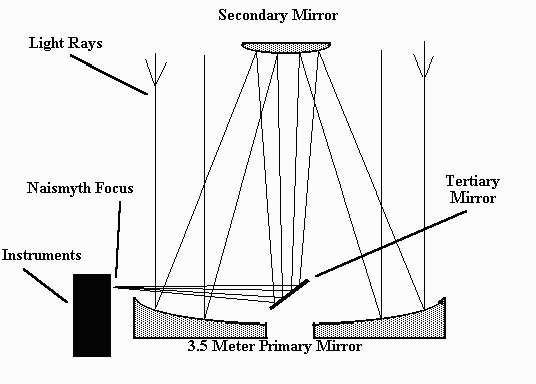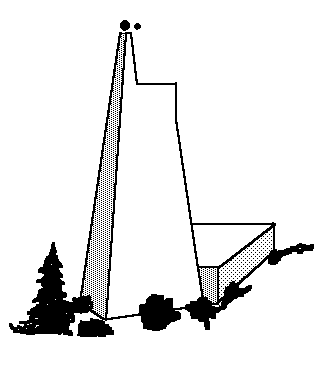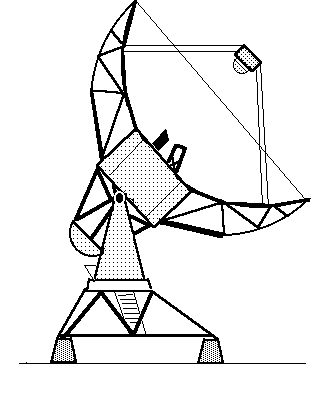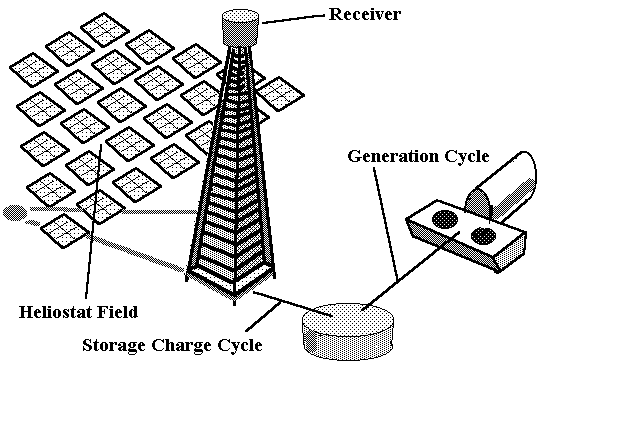Touring New Mexico's Astronomy-Related Sites
Jack Kramer
Among the various research facilities in New Mexico, several are of interest to amateur astronomers and are easily accessible. The vast open spaces, high altitude and dry atmosphere are particularly conducive to studies that require pristine atmospheric conditions. This is true even for studies of the radio spectrum at the VLA, since water vapor can slightly degrade reception at certain frequencies.
 Apache Point Observatory
Apache Point Observatory
In the Sacramento Mountains of southern New Mexico are four optical telescopes, including two of the newest instruments, a 3.5 meter optical-infrared telescope and the 2.5 meter telescope devoted to the Sloan Digital Sky Survey. An interesting aspect of this observatory complex is that it was the first to be designed for remote operation by astronomers in their home institutions using long-distance electronic networks and computers. The 3.5 meter primary mirror was made with the new spun-glass technology pioneered by Roger Angel at the University of Arizona. The molten glass is spun as it cools, yielding a rough curve to the desired focal ratio; after cooling, the final grinding and figuring takes place. The volume of the mirror is only 22% glass, the remainder is air, yet it's just as stiff as conventional mirrors. The weight of the entire telescope is 45 tons, which is about 1/4 the weight of earlier instruments of the same size. Unlike older telescopes housed under a dome, the 3.5 meter is housed in a box-like enclosure that rotates in unison with the telescope. The site itself is above much of the dust, vapor, and aerosols at lower elevations. The air pressure is 30% lower than at sea level. Under optimum observing conditions, the telescope could be used to read the date on a quarter held at a distance of one mile! Apache Point is owned and operated by the Astrophysical Research Consortium, which includes the University of Chicago. The primary work of this telescope will be the study of stellar evolution and galaxy formation. The 3.5 meter carries instruments to measure the brightness, position, color, and spectrum of celestial bodies. The 2.5 meter telescope is devoted to a mapping and spectrographic analysis project that will provide the distances to over one million galaxies and a hundred thousand quasars. There are two additional telescopes on site. A 0.6 meter instrument is used to provide calibration and sky monitoring for the 2.5 meter. There's also a 1.0 meter scope used for staff research by New Mexico State University. Visitors are welcome to walk anywhere on the grounds. Beyond the telescope complex, the distant views of the Tularosa Basin, Organ Mountains and the White Sands National Monument from Apache Point are breathtaking. At an altitude of 9200 feet, Apache Point is the third highest observatory in the United States after Mauna Kea in Hawaii and Kitt Peak in Arizona. (We "flatlanders" have noticed the effects of altitude when touring this site; shortness of breath and/or headaches are not uncommon.)
 National Solar Observatory at Sunspot
National Solar Observatory at Sunspot
About 11/2 miles north of Apache Point is the National Solar Observatory at Sunspot, N.M. Here there are several telescopes devoted to solar research. One of the more interesting instruments is the vacuum tower telescope, which rises thirteen stories above the mountaintop and extends 220 feet below ground. In most solar telescopes, sunlight heats the air in the telescope tubes, which causes unstable images. In the vacuum telescope, air is drawn out of the tube, creating an almost total vacuum. Sunlight enters the tower through a 30" window located 136' above ground. There, a pair of movable 44" mirrors direct the sunlight down a shaft to a cocave 64" mirror located 180' below the observatory chamber. This mirror sends a 20" diameter image of the Sun to the observatory chamber for detailed analysis. The entire optical system, plus the observing room floor, is suspended by a mercury float bearing. This allows the image of the Sun to be rotated in line with auxiliary instruments by rotating the entire telescope. The observing room is open to the public, even while observations are being conducted. In addition, a live TV image of the Sun from another telescope is piped into the visitors' lobby.
 Very Large Array Radio Telescope
Very Large Array Radio Telescope
On the high plains west of Socorro is the VLA facility, run by the National Radio Astronomy Observatory. Whereas optical telescopes are used to view objects at visible and near-visible wavelengths, a radio telescope creates images of objects from the radio waves they emit. The VLA is an array of 27 parabolic antennas arranged in a Y shape; each leg of the Y is 13 miles long. The 82 ft. diameter antenna dishes are formed to a curve accurate to 0.5 millimeters. These 235 ton antenna assemblies are adjacent to railroad tracks, which allows them to be picked up and moved in order to discern certain details in a radio image (resolution). When the farthest antenna is at the 13 mile position, the array is working at its maximum resolution, which is needed to probe the inner core of a galaxy. Bringing the array into its shortest arrangement would place the farthest antenna only 2000 ft. from the center. This would be used in order to view the large overall structure of a galaxy or objects nearer to Earth. Computers store the images as numbers, then arrange them in an image in various shades of gray or colors. One time when we visited, we watched as the computer displayed a color rendition of the heart of the Milky Way galaxy. One of the astronomers pointed out what they believed to be a black hole at the very center of our galaxy. On the premises is a small, but very informative museum. The VLA also forms part of the VLBA (Very Large Baseline Array), which is made up of radio telescopes all over the country that together act as a giant interferometer capable of extremely fine resolution.
 Sandia Labs Solar Power Research
Sandia Labs Solar Power Research
Sandia National Laboratory, south of Albuquerque, does research on nuclear, solar, and wind power for the U.S. Department of Energy. We've visited a variety of project sites, including an atom smasher and vertical-axis wind turbine. One of the most interesting projects is the Central Receiver Test Facility (CRTF), which covers about nine acres. This is a field of 222 individually guided mirrors, called heliostats, that redirect the Sun's energy to a receiver mounted atop a 200' tower. The solar energy is absorbed by a fluid such as molten salt, then pumped down to a storage system or used immediately to power a steam turbine. In full operation, the system can direct up to 5 megawatts of solar radiation; this can produce about 1,500,000 watts of electrical power. CRTF can generate temperatures over 4000oF, although the metal tubes that carry the fluid reach only 1000oF to 1500oF because the fluid carries away most of the heat. Guided tours take visitors for a walk out among the solar panels and demonstrate examples of solar power.





